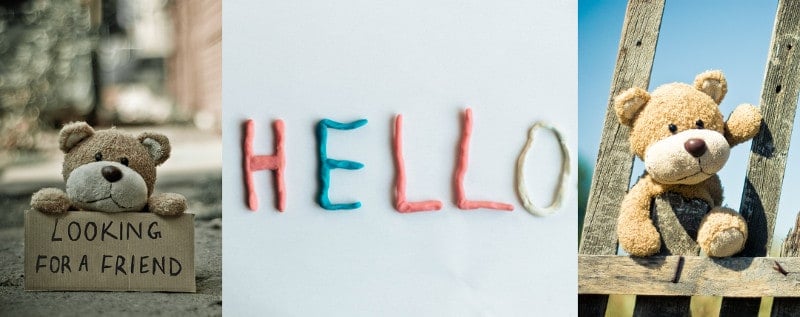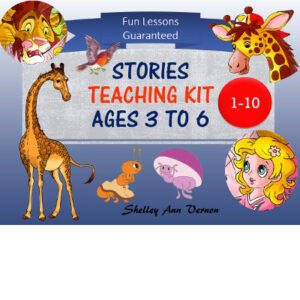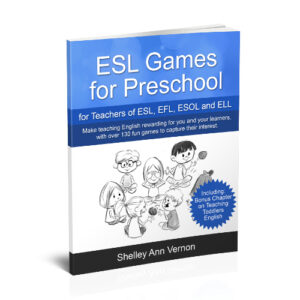Hello ESL teachers, welcome to this post on how to teach greetings at kindergarten for kids learning English. In addition, the activities in this lesson plan are adaptable to teach any words, not just hello and bye-bye.
An English teacher in Tianjin, China, asked me how to teach the following four words to preschoolers aged 3-5: Hello, bye-bye, ball, and hand.
How to teach greetings at kindergarten lesson plan
Whenever possible, demonstrate vocabulary words with gestures. Using gestures makes a word more real, especially to a preschool learner.
Hello and Bye-bye
Demonstrate the concepts of hello and bye-bye. Leave the room saying, “Bye-bye.” Go out and close the door behind you, but jump back in immediately, before chaos breaks out, and say, “Hello.” Do this three times. Then come in and say, “Hello,” and cup your hand to your ear, indicating to the class that they are to say, “Hello” to you. Continue going in and out and have the kids say “Bye-bye” and “Hello” to you each time. By all means, please teach goodbye instead of bye-bye if you prefer.
Here is another funny idea for how to teach greetings at kindergarten. First, make a pretend door in the classroom, perhaps with two chairs back to back and a space between them. Then, drape a sheet over a desk. First, demonstrate. Go out through the pretend door and disappear behind the sheet, saying, “Bye-bye.” Next, have four children do this too, saying, “Bye-bye” to the class. The class should reply with “Bye-bye.” You get the idea. Preschool children will enjoy this, even though it is such a simple activity. Enhance it by giving those going in and out a hat to wear.
Alternatively, teach greetings with a teddy bear. A teddy bear arrives from behind your back or jumps out from a box and says, “Hello!” Have pupils reply with, “Hello.” Then, teddy waves goodbye, and everyone says, “Bye-bye.” You can wave teddy’s little paw and then have it disappear behind your back or back into the box.
From now on, use these words in every lesson, and your preschool learners will soon become confident using them.
Hand
Although “Hand” is the only body part on your list, I would teach it with “Foot.” Avoid left hand and right hand since preschool children can’t grasp that concept. Instead, contrast with “Foot” and possibly “Head.” Use mime and have everyone touch something red with their hand and something blue with their foot. Touch your foot with your hand. Now touch your head with your foot. Next, touch Phuong with your hand. Finally, touch a chair with your foot. The teacher demonstrates, and the kids copy.
If touching anything with a foot is perceived as rude, replace it with “elbow.”
Ball
Any teacher who finds managing preschool children a challenge should be wary of balls. They often excite children, especially boys! Only let well-behaved children, who are sitting nicely, touch the ball. Then, roll the ball across the floor to a child. Finally, tell the child to stop the ball with their hand or foot (or elbow). Preschoolers should enjoy that, but you can’t do this activity if you have 25 kids in your classroom. The other 24 will be too bored waiting for a turn!
Next, place a teddy in one box and the ball in another and ask five children to come to you. Tell them to touch either the ball or the teddy. This calmer activity will keep pupils from getting out of hand with a ball flying all over the classroom!
If your preschool class is manageable, try asking pupils to roll a ball along the floor to the student opposite. For example, have pupils roll the ball to the red corner or the blue corner. Alternatively, place students in the four corners and have pupils roll a ball to the pupil you name. If anyone is naughty, look at them, point to the pretend door you set up earlier, and say, “Bye-bye.” Then have them over to sit with you. Be kind but firm.
Resources for how to teach greetings at kindergarten
If you get my preschool games book, you will have plenty of ideas as Jessica Duguet Souber-Broglio from France says:
“I totally recommend this book, and I have been so happy and stress-free since I bought it. It gave me a clear understanding of how to teach preschool kids.
I am a new ESL teacher who was “freaking out” before reading it. Now I am a happy teacher looking forward to my lessons with my pupils. This book is my number 1 resource and I will keep it forever. I am just a little bit sad that I didn’t discover it earlier, as it would have made my first months so much more enjoyable and relaxed.
I like the structure and the extra advice inside. Contrary to other books, you don’t spend a lot of time thinking about the activities as it presents them so clearly. It improved my planning time and the quality of my lessons. I am now a happy customer, and I also bought other resources from the author, and they are great. In addition, I love the stories and that they come with clear lesson plans and resources already made.”
Let me know how it goes in the comments box below!
All the best
Shelley Ann Vernon
PS. And by the way, the intro of my preschool games book has plenty on managing the class. (If you have a Chinese assistant, get them on your side urgently!)
-
Sale Product on sale
 Special Days Stories Teaching Kit + PowerPoints
Special Days Stories Teaching Kit + PowerPoints$47.96Original price was: $47.96.$35.20Current price is: $35.20. -
Sale Product on sale
 ESL Preschool Stories 11-20 Teaching Kit + PowerPoints
ESL Preschool Stories 11-20 Teaching Kit + PowerPoints$47.96Original price was: $47.96.$35.20Current price is: $35.20. -
Sale Product on sale
 ESL Preschool Stories 1-10 Teaching Kit + PowerPoints
ESL Preschool Stories 1-10 Teaching Kit + PowerPoints$47.96Original price was: $47.96.$35.20Current price is: $35.20. -
Sale Product on sale
 Preschool games book
Preschool games book$23.96Original price was: $23.96.$14.36Current price is: $14.36.





4 thoughts on “How to teach greetings at kindergarten”
Thank you forma tour ideas. I will práctice them with my children..
Waiting forma tour news….. Yours truly..
Dina G.
Hi teachers, in case you think the above ideas are nuts, I just wanted to quote you the email I have just received from a teacher:
Thanks so much for the resources you sent me. They are already proving very helpful and my kids just love the hello and bye activity.
Yes the balls activity also work perfectly for the balls and it’s been great. I hope to continue having a great time teaching here.
Great ideas as usual! I am looking forward to using them with my children at school.Thank you very much!
Dear Violeta, Thanks for your comment. I hope it all goes well. If you need me for anything, just ask! All the best, Shelley